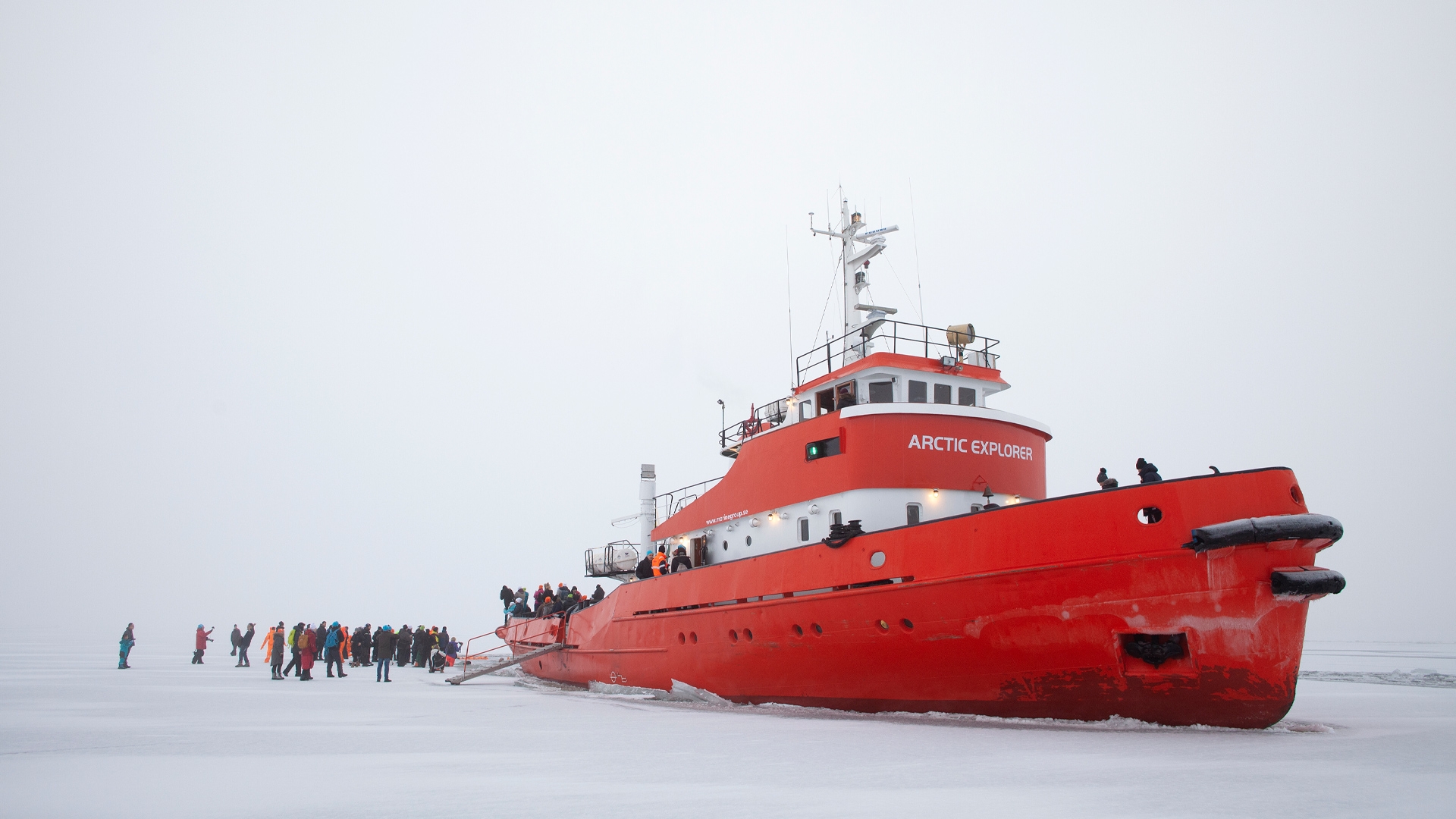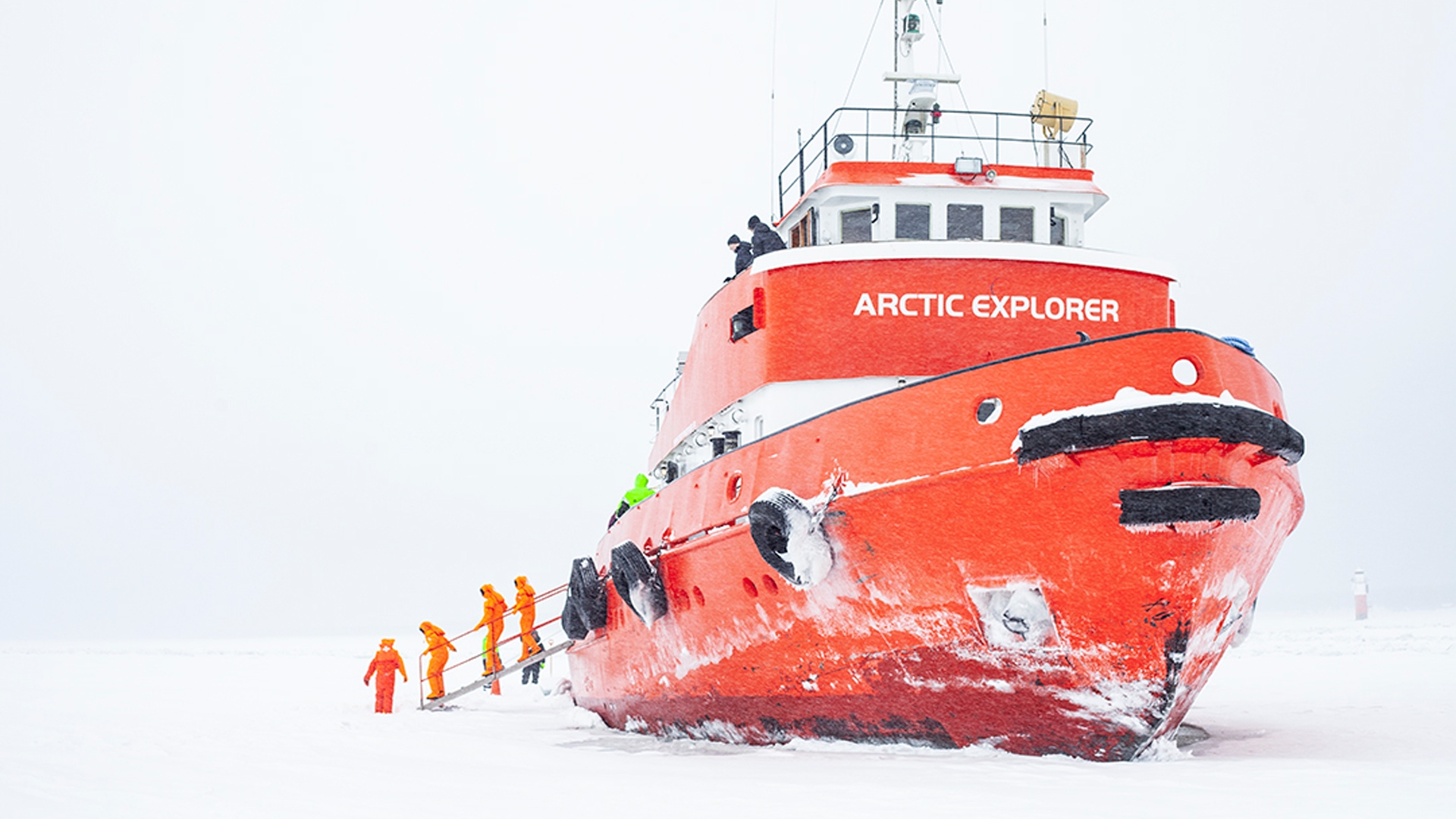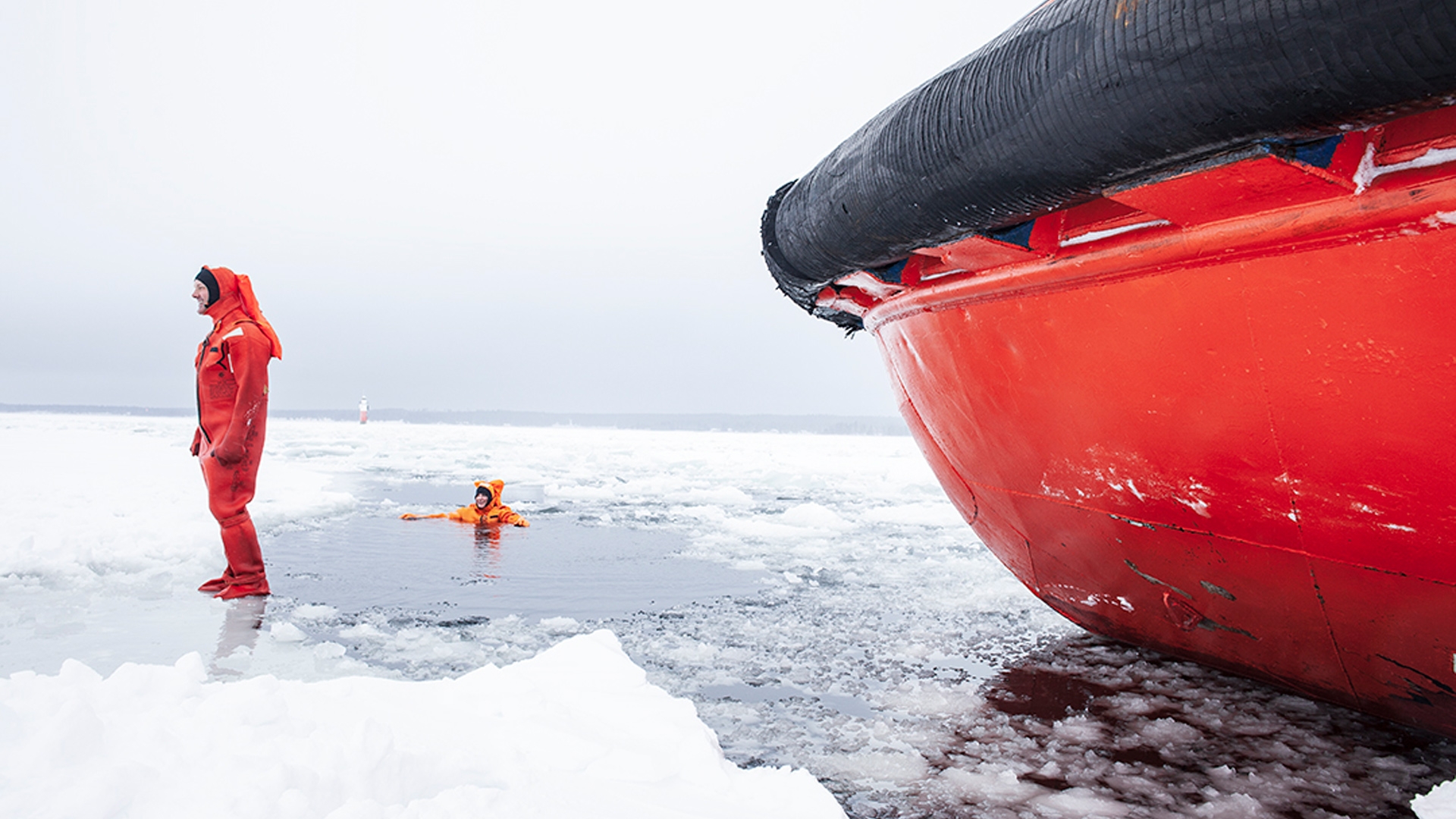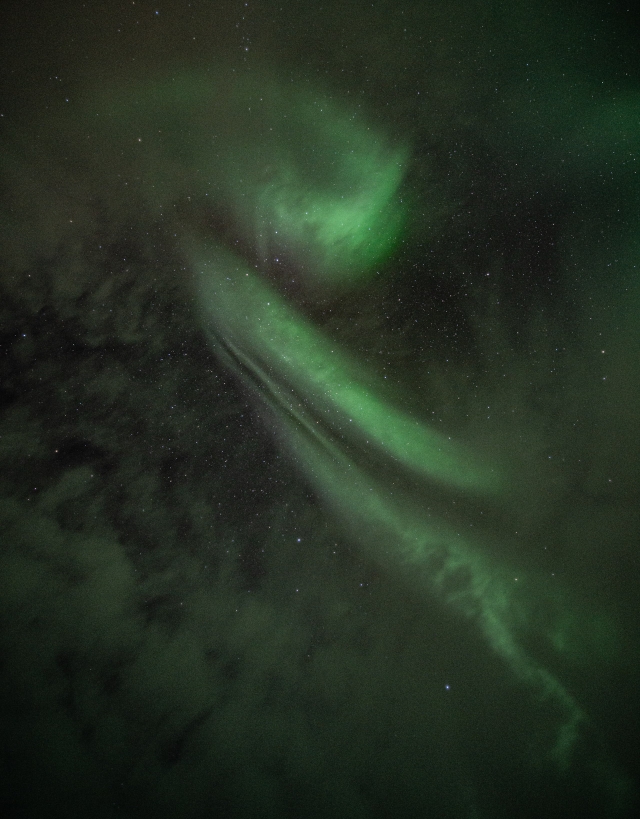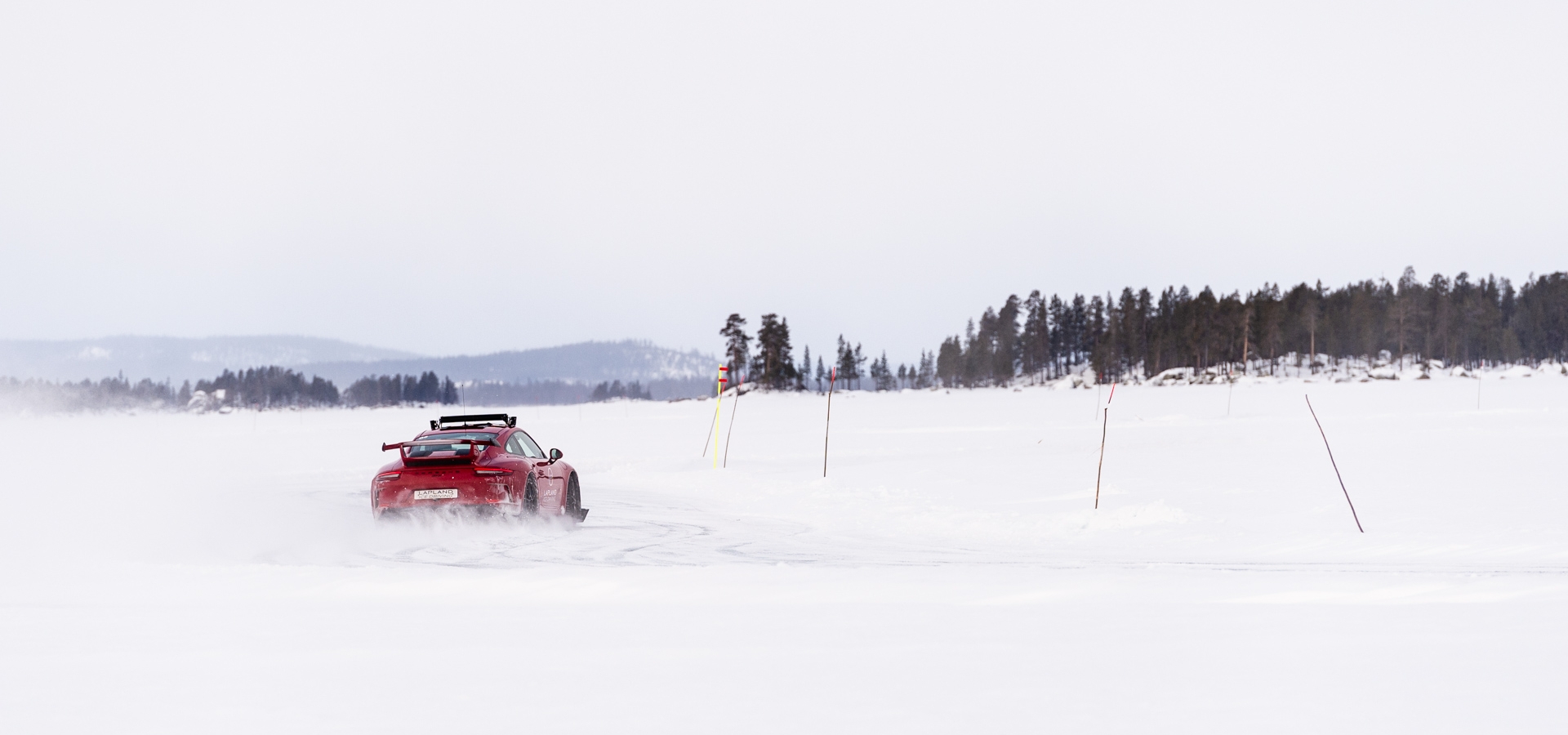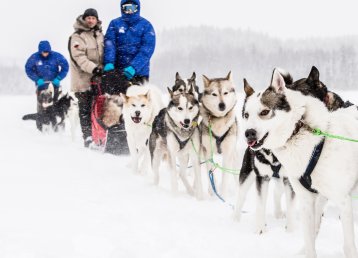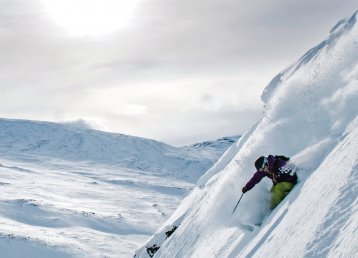Boat trips in summer and early fall are a given part of life for the residents of Piteå, a city in the Bay of Bothnia blessed with a rich archipelago. In the Bothnian Bay archipelago, there are small as well as larger islands. Here we find picturesque places and areas where the great rivers that run from the mountains in the west meet the ocean.
In summer many tourists come to Piteå and the well-known resort Pite Havsbad to experience this. At the resort, often called the Riviera of the North, the camping site is filled with cottages, caravans and thousands of visitors. However, winter tourism has grown over the years, and boat trips have become the primary attraction. For the uninitiated, it may sound contradictory that tourists flock to boat trips in the middle of winter, but in that contradiction lays the unique pull of the experience.
Warm clothes, thick caps and tons of anticipation
In the lobby of the hotel building at Pite Havsbad, a group of people has gathered. It’s a Saturday morning in early March, and two things serve as common denominators for everyone here: warm clothes and thick caps. For the most part, similarities end there. As I listen to the chatting in the lobby, I’m able to make out at least a handful of different European languages. That people from all over the world gather here for the same reason that they’ve gathered here today is nothing unusual. And even though I don’t understand most of what is said, I can clearly feel the anticipation in the air.
After a couple of minutes, the guide for the day approaches and greets us. When we have gone over the schedule for the day, it’s time to walk to the boat for a safety briefing by the captain. While walking, I take the chance to ask the guide about what the guests appreciate the most with these boat tours:
– For many foreign guests, it’s the first time they walk on frozen water, which of course is quite an experience. Others think the most amazing part is bathing in a hole in the ice, says the guide, Ulrika.
I’m curious about the swimming part.
– How does it work when they’ve bathed, do they warm up in a sauna onboard the boat afterwards?
– No, they receive dry towels, but they get to use special rescue suits when they bathe, which make sure only their hands get wet, Ulrika explains.
The vast white landscape of ice
After a short walk, we arrive at Pitsundskanalen, the mouth of the mighty river Piteälven. It meets the sea here after a 400-kilometre journey from Sulitelma glacier in Norway.
On the landing stands the captain and when the safety briefing is completed, we are allowed onboard Arctic Explorer, as the boat is called. Soon the great diesel engine of the icebreaker lets out a groan from below, and the deck beneath our feet comes to life with a slightly massaging vibration. The obligatory smell of diesel oil that fills the air enhances the atmosphere considerably.
As we chug out towards the ice-covered sea, we pass what is colloquially referred to as Guldkusten – The Gold Coast – a string of riverside villas and gardens. One of the guides tells us of one earlier trip that took place shortly after a snowstorm that left the Gold Coast villas covered in snow, looking abandoned. The curious view made one of the tourists ask about the nice abandoned houses.
Also read
Explore the seaWhen we’ve left the rapid-flowing waters of Pitsundskanalen and reached the open sea, all the passengers gather on deck. Soon the thing everyone is here to experience will be upon us; a mere hundred metres ahead the vast white landscape of ice stretches out as far as the eye can see. Will the icebreaker cut through all that ice like a hot knife through butter, or are we in for a collision like the one that the passengers of the Titanic so bitterly experienced in 1912? Excitement is reaching its climax.
We meet the edge of the enormous ice shelf with a speed of about 5 knots. Even though we’re on a steel-clad colossus that measures 37 metres and weighs 400 metric tons, the ice certainly puts up a fight. As the Arctic Explorer eats through the solid white surface that shelters the Gulf of Botnia like a down quilt, its spastic movements force the passengers to hold on to something. Muffled cracking sounds from the ice giving way are mixed with the rumble of the diesel engine.
Ploughing through the thick ice
Next to me stands a man who has chosen to shelter his face from the cold winds with the hood of his jacket. His name is Kurt, and he’s from Salzburg, Austria, and I can’t stop myself from asking how he ended up on an icebreaker in Piteå.
– I’ve come here to experience the winter and northern Europe, it’s all completely new to me. I’ve never been north of Stockholm before, Kurt tells me and continues:
– So besides from this icebreaker tour, we’ve tried walking with snowshoes, gone dogsledding, driven go-karts and hovercrafts on ice – lots of stuff that I haven’t done before!
– What has been the best thing this far?
– Oh, that’s difficult to say! Maybe the dog sled ride, it was an awesome experience that offered a combination of speed, adrenaline and nature, says Kurt.
After ploughing through the seemingly infinite sea of ice for some time, the Arctic Explorer turns back toward the mainland. In a vast bay covered by ice, we stop for the next event on the trip. A gangplank is felled out, landing with a thud on the ice. The passengers flock by it and soon, one by one, they disembark to wander around on the thick ice. Soon the frozen sea is swarming with tourists amazed by the feeling of walking on water.
Time for a swim
In the trail behind the mighty icebreaker, dark water mixes with great blocks of ice. More and more of the passengers find their way to a point around 20 metres behind the boat, waiting for the highlight of the day: bathing in the ice-cold water. After a couple of minutes, two orange figures leave the boat to join them: the tourists who will go first into the dark waters.
The captain watches over the well-clad bathers, all the time providing soothing instructions. The faces of the two orange tourists tell me their feelings are a mixed bag of delight and fear as they slowly lower themselves into the freezing water.
After a couple of minutes of splashing and attempts to make it out of the cold water unaided, they are helped back up onto the ice to make way for others. Soon, one of the first bathers return from a quick change into warm clothes aboard the ship, and I seize the opportunity to get a report from someone who’s been in the cold water.
She introduces herself as Monica from Älvsbyn, a municipality neighbouring Piteå. She’s on the trip with her family and reveals this was her first time bathing in ice-covered waters.
– How was it?
– It certainly was an experience, but it was also slightly unpleasant. I’m scared of deep waters and sharks, Monica says with a laugh, well aware that the risk of shark attacks is strikingly low around here.
Winter swimming
Rachel Davies has lived and worked in Abisko, Swedish Lapland for some years. And being a swimmer this means she had to adapt to cold water. So she did.
400 tons
The group of tourists wandering on the ice is comprised of both families, and larger travel groups and the obligatory photos where people pose in front of the Arctic Explorer are being taken at a quick pace. I take the opportunity to ask him about the difference between an icebreaker and an ordinary boat.
– The prow has a round shape, almost like an egg, and this one has a steel thickness of 20 millimetres, captain Tomas explains.
– What is the maximum ice thickness it can break?
– Around 50 centimetres, and when it’s minus 20 degrees Celsius, you have to go out at least every other day for the lane to stay open.
The durability of the ice depends on many factors. Whether it’s solid or comprised of many layers, due to periods of shifting temperatures, is one such factor. Another one is whether or not there are air pockets or other elements, making it weaker.
To be able to withstand great pressure, the ice doesn’t need to be all that thick. 50 centimetres of ice easily carries a truck. In other words, the 400 metric tons of the Arctic Explorer comes in handy when you want to make your way through the ice.

Arctic Explorer
The icebreaker Arctic Explorer weighs about 400 tons and can break up to 50 centimetres thick ice.
When all the photos are taken, and all passengers hungry for the unique experience have had their opportunity to bathe, we retire to the boat. The spastic movements and the cracking sounds still make up the backdrop for our conversations.
The rest of the journey home gives room for reflection, and we all agree that it’s truly something special to be on a boat at sea. Of course, this shouldn’t be news to me as a resident in the area, but even so, I will vividly remember the powerful experience of the Arctic Explorer ploughing through the thick ice of the Gulf of Bothnia.
Learn more
To find out more about the icebreaker tours, visit icebreaker.fi.














